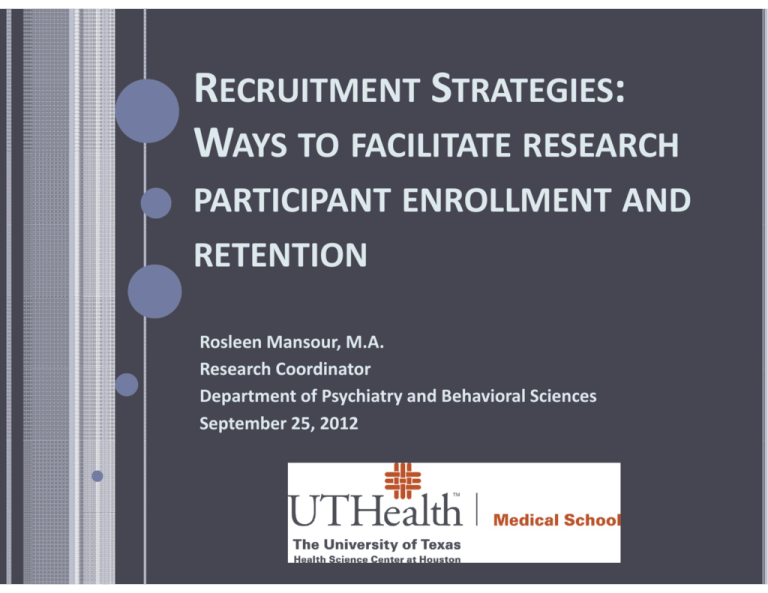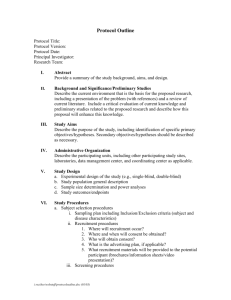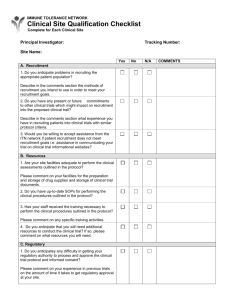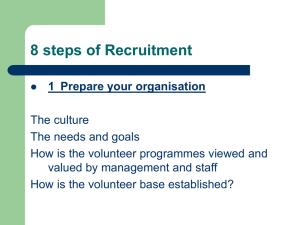RECRUITMENT STRATEGIES RECRUITMENT STRATEGIES
advertisement

RECRUITMENT STRATEGIES: WAYS TO FACILITATE RESEARCH PARTICIPANT ENROLLMENT AND RETENTION Rosleen Mansour, M.A. Research Coordinator Research Coordinator Department of Psychiatry and Behavioral Sciences September 25, 2012 RECRUITMENT ISSUES (SOURCE: MARITHEA GOBERVILLE, PH.D) | Patient recruitment is the leading barrier in conducting studies | 50% of sites enroll 1 or 0 patients p | 6% of clinical trials are completed on time | “Time Time to market to market” is key concern for sponsor is key concern for sponsor | Can cost up to $1 million/day for delays in getting drug to market tti d t k t STEP 1: S 1: STUDY DESIGN/REVIEW/CONTRACT Reviewing the protocol/contract: | What is the target enrollment? N=??? N Expected recruitment rate? Maximum N, minimum N? y Multi‐site trials: Is enrollment competitive? y Will the study be terminated once enrollment met? y Ideal to have flexible target enrollment y | What are the recruitment milestones/timelines? | Target population: review of inclusion/exclusion criteria | What is the expected screening failure rate? | What is the design of the study (e.g., Open Label vs. g y g p Placebo‐controlled), risks, potential benefits? SAMPLE CONSIDERATIONS (CPHS) | Cultural diversity is strongly encouraged | Your clinical trial sample should be representative of Y li i l t i l l h ld b t ti f the local population affected by the condition in terms of: y y y Ethnicity/Race Gender Age | Economically disadvantaged subjects: costs related p p p to research should not preclude participation and financial remuneration, reward, or reimbursement for expenses must not be coercive to potential participants | Exclusion of a particular group may only be justified in certain cases (see CPHS Recruitment guidelines) STEP 2: 2: RECRUITMENT PLAN 1. What strategies have been successful in the past? 2. What resources do you need? 2. What resources do you need? 3. How will you recruit? y y y y y y y y Databases Approaching existing patients in clinic Advertising (tv, radio, newspaper) Sponsor referrals Community outreach External clinics/schools/facilities Websites/internet Advisory board/focus groups/surveys on patient sources and needs? 4. How will you ensure diversity? 5. When can you start to recruit??? What do you need to accomplish before you can recruit? y y y y y Contract/budget IRB Training Site Initiation visit Ordering of supplies 6 Subject renumeration compensation reimbursement? 6. Subject renumeration, compensation, reimbursement? STEP 2: R 2: RECRUITMENT PLAN: C : COMPENSATION? 1. 2. 3 3. 4. 5. Must not be coercive and must be approved by IRB Compensation must be equal to all p q participants Reimbursement for expenses Reimbursement for expenses Compensation for time commitment C Compensation for inconvenience or ti f i i discomfort STEP 3 3‐BUDGET | How much is it going to cost for you to recruit and screen? | What is the sponsor contributing to recruitment? y E.g., Advertising firm? National campaign, materials? | Recruitment costs: Costs for advertising, flyers, website design y Costs for staff time (community networking, developing recruitment materials, posting information, contacting l f colleagues, contact participants,) y | Screening costs : Screening costs : Telephone screening y Screening failures Screening failures y PLANNING‐BUDGET PERSONNEL TIME Time estimates Screen Timeline in Study Item Patient Qualification/Screening Recruitment Administrative Time (reg binder, filing, billing) Phone screening Visit Prep/Scheduling Informed Consent Inclusion/exclusion Patient History Physical Exam Vital Signs Menarcheal status (female) Urine Pregnancy Test Personnel Needed * SC SC SC SC SC SC MD MD MD MD SC Pre‐visit Dose Titration MAINTENANCE Visit 0 Visit 1 Visit 2 Visit 12 Visit 13/Final Screen Visit Baseline Week2 Week42 Week48 60 30 30 30 20 15 5 15 60 60 60 60 15 5 15 15 5 15 5 15 5 15 Total/participant 60 60 30 Serum Pregnancy Test SC/Nurse/CRU 10 Clinical Laboratory Tests 12-lead ECG Reading of ECG assessment1 assessment2 assessment3 assessment4 assessment5 assessment6 assessment7 t7 assessment8 assessment9 Adverse event collection Prior/con meds IP dispensed IP instruc/compliance/accountability SC/Nurse/CRU SC MD SC SC SC SC SC SC SC SC MD MD SC SC/MD SC 45 20 10 25 180 90 30 15 15 15 10 45 20 10 30 15 20 30 15 20 15 15 15 15 10 15 15 15 10 10 15 15 10 10 15 15 10 10 15 15 20 20 45 30 20 20 45 30 20 20 45 30 20 20 45 30 15 20 45 30 45 20 20 20 20 45 20 13.83 1 83 1.83 1.33 8.67 5.92 0 83 0.83 0.67 3.00 4.33 0 58 0.58 0.33 1.42 3.83 0 33 0.33 0.33 0.92 7.92 1 00 1.00 0.92 4.33 83.08 8 75 8.75 6.50 30.67 $ 130 $ 45 $ 25 $ 15 $ 65 $ 485 Post Visit Processing Regulatory/Electronic R l t /El t i llogging i Scoring of measures Completion/collection/review of study forms Data entry Processing Lab samples PI review of CRFs Team administrative (meetings, trainings)/mo Total Study Coordinator (SC)Time (hr) Total Physician (MD) Time Total PI Time (hrs) Total Participant Time (hrs) Particpant reimbursement SC SC SC SC PI Team 2.50 PLANNING‐BUDGET SPONSOR BUDGET WORKSHEET - Costs Billable To RESEARCH Study Principal Investigator: Study Title: Sponsor: Start Date: A. ***STARTUP COSTS (non-refundable): Investigator Meeting Base - 30% IDC - TTL Inv. - IRB Fee: Awards >$50,000.00 = $2000 Protocol submission Consent development Administrative Fee: (budget, contract, recruitment, regulatory set-up) CRU start up Other: Long Distance SUB-TOTAL STARTUP COSTS C. PER PATIENT COSTS: $ 3,000.00 $ 3,000.00 Standard of Care (SOC) or Research Pre-screening Research (R) Visit 0 Screen Visit $ Visit 1 Baseline 900.00 3,900.00 900.00 3,900.00 Visit 2 Week2 Visit 3 Week4 Visit 4 Week6 Visit 5 Week9 Visit 7 Week18 Visit 8 Week24 Visit 13/Final Week48 Telephone screen Research (R) Informed consent Research (R) $ 100.00 Physical exam/med hx Assessment 1 Assessment 2 Clinical Laboratory Tests ECG readings Research (R) Research ((R)) Research (R) $ $ $ 150.00 100.00 100.00 $ 50.00 $ 50.00 $ 50.00 $ 50.00 $ 50.00 $ 50.00 $ 50.00 $ 50.00 Research (R) Research (R) $ $ 100.00 100.00 $ $ 100.00 100.00 $ $ 100.00 100.00 $ $ 100.00 100.00 $ $ 100.00 100.00 $ $ 100.00 100.00 $ $ 100.00 100.00 $ $ 100.00 100.00 $ $ 100.00 100.00 Prizes, treats, supplies Patient Stipend Patient Parking SUB-TOTAL PER PATIENT COSTS Research (R) Research (R) Research (R) $ $ $ 5.00 50.00 20.00 $725.00 Total $ 30.00 $ 30.00 $250.00 $250.00 $250.00 $250.00 $250.00 $250.00 $250.00 $250.00 Number N b PATIENT Telephone Screened 50.00N Phone screen NUMBER OF PATIENTS Screened 20.00N SCREEN NUMBER OF PATIENTS Enrolled 10.00N ENROLL SUB-TOTAL PATIENT COSTS D. ***OTHER INVOICE ITEMS: UPON OCCURRENCE Recruitment costs Unscheduled Safety Visits Unscheduled SRS FDA Audit Fee IRB Fee - Continuing Review Amendment Querie Resolution SAE Total of Other Invoice Items $ 36,000.00 TO BE INCLUDED IN CONTRACT Base 30% IDC TTL Invoice $ 9,200.00 $ 2,760.00 $ 11,960.00 *Total Amount to Be Received From Sponsor * (does not include "Other invoice items") Other invoice items will be invoiced as they occur *Note: Total amount to be received is based on an estimated recruitment numbers of subjects. Final total is subject to change according to actual number of participants STEP 4: 4: DEVELOP RECRUITMENT MATERIALS | Flyers/Brochures/Tearsheets Templates available from CTRC: http://www.uth.tmc.edu/ctrc/recruitment.html y Example flyer y | Ads (radio, newspaper, tv): develop scripts | Website content | Collecting information electronically or through Collecting information electronically or through the web: Caution: confidentiality of participants must be Caution: confidentiality of participants must be protected y All PHI must be kept on secure servers in zone 100 All PHI must be kept on secure servers in zone 100 y STEP 4: 4: DEVELOP SCREENING MATERIALS | Pre‐Screening participants y With CPHS approval of waiver of authorization, the study team may conduct preliminary screening through research registry or conducting telephone screens | Screening form, including: Inclusion/exclusion criteria y Potential participant contact information y | Recruitment script that explains how the person’s name was obtained, introduces study design, bt i d i t d t d d i requirements, risks, benefits, study medication, location of the research location of the research | Caution: No participants can undergo study p procedures (e.g., discontinuation of prohibited ( g, p medications until they are consented) CLINICAL TRIAL WEBSITES | Clinical trials.gov Online database of federal and sponsored trials y Registration of certain clinical trials is mandatory y | Research Match: y tool that helps connect volunteers with researchers. tool that helps connect volunteers with researchers. The database will sent invitation notices to potentially eligible volunteers | UT Health Clinical Trials page y Maintained by CTRC y ASSEMBLE SCREENING TOOLS | Screening logs: documentation of participants screened, including dates, reason for exclusion, and if possible gender and age | Waiting Lists | Participant database: for future research Participant database: for future research STEP 5: IRB APPROVAL All advertisements and recruitment methods/materials must be reviewed and approved by CPHS All advertisements and recruitment methods/materials must be reviewed and approved by CPHS prior to implementation to assure that the information does not promise or imply a certainty of benefit beyond what is contained in the protocol/informed consent. Guidelines for Recruitment Flyers, Ads, Posters, & Brochures http://www uth tmc edu/orsc/guidelines/recruitment html http://www.uth.tmc.edu/orsc/guidelines/recruitment.html Recruitment Information should include some of the following elements (those in bold are mandatory): | “Research” is specified. | The ages for eligibility. | I l i /E l i Inclusion/Exclusion criteria (e.g., “Right‐handed Participants only”). it i ( “Ri ht h d d P ti i t l ”) | The purpose of the research must be clearly stated. | The amount of time required to complete the study. | Any benefits (Note: a straightforward and truthful description of the benefits to the subject for participation in the study e g no charge for taking part in the study no‐cost health examination or providing treatment and study, e.g., no charge for taking part in the study, no‐cost health examination, or providing treatment and counseling for the drug addictions.) | Any risks. (Note: If there are minimal risks other than mild boredom or mild fatigue, you may either include them or state that they will be discussed prior to the beginning of the study.) | The contact person’s name is identified. | The institution is identified. | Monetary compensation information is optional. (Note: Although the consent document must specify the EXACT amount of any financial compensation, recruitment materials should state that monetary compensation will be provided. | The location of the research The location of the research. | Things that should be avoided: Do not emphasize monetary compensation. Do not state the amount of compensation. Do not use catchy words such as “exciting”, “cutting‐edge”, etc. Do not recruit children directly. recruit children directly Do not misstate information contained within the protocol STEP 6: R 6: RECRUIT! Develop and maintain community relationships | Network with other providers, schools, and groups | Establish give and take relationships with the community Post Flyers in various locations | Identify locations where you will find potential participants (ensure you receive approval to post) y y y y y Hospitals Clinics l Facilities Schools Supermarkets, libraries, employment centers, Mailouts | Send letters and flyers to colleagues, support groups, past patients Advertise | Start with UT Media | Radio, tv, newpaper Radio tv newpaper | websites Presentations | Start with your department, school, institution | Support groups, organizations Attend Community events | Fundraisers | Resource fairs UT RESOURCES UT R | Office of sponsored projects | CTRS http://www.uth.tmc.edu/ctrc/recruitment.html | CPHS p // / /g / http://www.uth.tmc.edu/orsc/guidelines/recruitm ent.html | Media Relations http://www.uthouston.edu/advancement/publi c‐affairs/media‐relations.htm | Office of communications/graphic design (websites, flyers, logos) | Office of Advancement/Communications/design STEP 7: S 7: SCREEN! Have staff available to take calls | Train your staff Train your staff | y y y y y y y y y y y | GCP training? Knowledge of protocol, inclusion/exclusion Knowledge about condition and study population Confidentiality issues Communication style (a lot of information presented y ( p understandably and in a non‐coercive manner) Ability to establish rapport with potential participants Ability to listen, be polite, yet keep calls as a screen and redirect y p y p participants to the screening interview Cultural considerations Safetyy Ability to be sensitive in explaining if did not meet screening criteria Ability to refer to services if needed Continuously update the waiting list STEP 8: ASSESS YOUR RECRUITMENT STRATEGIES | Obtain the source of the referral when screening | Evaluate recruitment milestones | Revise recruitment plan as needed (with Revise recruitment plan as needed (with approval from CPHS) | Obtain feedback from participants on reasons Obtain feedback from participants on reasons they did/did not participate and the screening experience in general experience in general | Periodically re‐distribute flyers and re‐send l tt t letters to colleagues ll RECRUITMENT CHALLENGES | Study visit burden y inform participant of number of visits, length of visits and study length | Inform participants of study requirements from the onset (e.g., prohibited concomitant medications, no new therapies) | Assist participants with appts/planning visits p p pp /p g Confirm and remind for upcoming visit (emails, cards, calendars) y Provide doctor excuses for missed work/school y Transportation (maps, costs to travel) p ( p, ) y RECRUITMENT CHALLENGES | Consenting challenges y y y y y Apprehension of participating in clinical trial and taking A h i f ti i ti i li i l t i l d t ki new medication Fear of non‐FDA approved drug Fear of adverse affects Reluctance to risk receiving placebo Fear of study procedures (e g blood draws or other Fear of study procedures (e.g., blood draws or other procedures) Having a well‐trained and understanding clinical staff and PI to help address these concerns staff and PI to help address these concerns ¾ Providing participants with the safety nets they ( ,p g , need to feel comfortable (contact numbers, pagers, emergency information) | Current trends in community/condition ¾ RETENTION STRATEGIES | Visit Experience y y y | Avoid and Address False Expectations Avoid and Address False Expectations y y y | Be continuously honest about study limitations Be sympathetic to concerns about lack of response/remind patients contributing to science PI should be available to address patient concerns/questions PI should be available to address patient concerns/questions Build and maintain relationships with participants y y y y | keep visits as smooth and brief as possible by preparing ahead for participants, not over‐scheduling, and ensuring wait times are minimized Have waiting room materials (magazines, toys) Reduce annoyances/barriers to participant (e.g., parking convenient, wait time) Study personnel should be professional and pleasant Use clinical skills and empathy to help participants with difficult procedures Conduct specialized training with study staff if specialized population (e.g., children, aggression, etc) Establish trust with your participants Communication/Follow‐up Communication/Follow up y y y Call participants between visits to check in (especially if long interval between visits) Confirm and remind of upcoming appointments Obtain updad contact information for participants RETENTION STRATEGIES | Keeping eligible participants, eligible: Re‐affirm/remind of exclusion/prohibited concomitant medications at each visit y Anticipate problems/issues for each specific participant A ti i t bl /i f h ifi ti i t (e.g., cannot swallow compound, side effects, coordination of care)) y Counsel on strategies to improve IP compliance y Remind of importance of visit windows y | Explain the preferred process for dropping out of the study (e.g., importance of being evaluated and returning study medication) | If participant needs to be terminated from study provide follow‐up referrals (leave on a good note)







